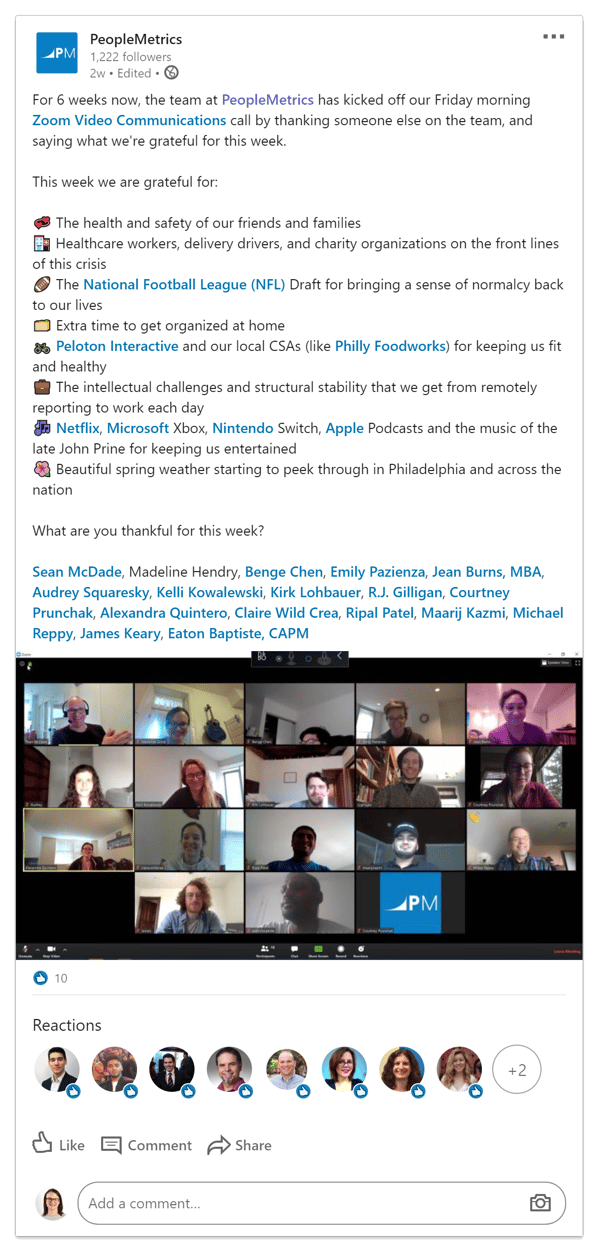In his book The Rise of the Creative Class, Richard L. Florida highlights the factors that motivate creative workers like software developers and scientists.
One of his conclusions is that increasing numbers of modern workers are motivated, at least in part, by peer recognition.
This has not changed by the remote work trend that is upon us. It is in fact even more important than ever!

The Power of Peer-to-Peer Recognition
Fortunately, leaders are beginning to recognize the power of peer-to-peer recognition.
In addition to the motivational factor, many managers encourage peer recognition because they know that it is usually accurate.
As Judith A. Hale explains in Performance-Based Management, peers may deliver more detailed, effective feedback, since they have more opportunities to observe their coworkers’ performance.
As Ms. Hale writes,
It is not uncommon for the manager to be removed from where the work is performed and, therefore, rarely see what people do or how they do it.
If you’re looking to develop a peer recognition program for your workplace, keep a few general feedback guidelines in mind:
- Remember that specific feedback is more effective than general praise. Encourage your employees to be precise when complimenting their peers.
- Additionally, you should involve employees in designing your peer recognition program. Your new recognition procedures will be far more likely to take root if everyone in your organization understands why they are being implemented.
- It’s also important that everyone in your firm has equal opportunities to give and receive feedback. Set up a level playing field. Make it easy to give recognition.
- Your system should aim for immediate gratification. Don’t let peer compliments pile up for weeks or months, since employees will be more motivated by timely feedback.
- Finally, keep in mind that employees follow their managers’ lead; your managers and executives must lead by example, especially in providing helpful, positive feedback.
As you discuss possible programs with your team, here are a few examples of how companies incorporate peer-to-peer recognition:
- The Recognition Raffle. Each time an employee receives recognition from a peer, he or she is entered into a raffle.
- Let the Most Kudos Win. Employees fill out a card or form to thank, compliment, or recognize their peers. The cards are then displayed on a central bulletin board to foster a positive work environment. Regularly, managers review the kudos board and award the employee who has received the most peer recognition. (If you choose this method, you might also incorporating a raffle, to avoid popularity contests.)
- The Company Store. Employees receive points for each peer recognition. Points may be accumulated and traded in for prizes at The Company Store. Your prizes don’t have to be big; perhaps five recognitions would be enough to earn an extra hour off, for instance.
If any of these suggestions seem too daunting, I’ll offer a suggestion that we have implemented at PeopleMetrics since March when we began to work remotely due to COVID-19.
At the end of our company meeting each Friday, everyone goes around in our Zoom call and shares one thing that they are grateful for in their life and thanks one person at the company that helped them during the week:
It’s simple, powerful and an example of how peer-to-peer recognition can work for any company.
|
It's time to start measuring employee experience! Contact PeopleMetrics: |
About the Author
Sean McDade, PhD is the author of Listen or Die: 40 Lessons That Turn Customer Feedback Into Gold. He founded PeopleMetrics in 2001 and is the architect of the company’s customer experience management (CEM) software platform. As CEO, he guides the company’s vision and strategy. Sean has over 20 years of experience helping companies measure and improve the customer experience. Earlier in his career, he spent five years at the Gallup Organization, where he was the practice leader of their consulting division. His company offers CEM software with advanced machine learning solutions and hands-on analytical support to help companies make sense of their CX data. Sean holds a Ph.D. in Business Administration with a specialization in marketing science from Temple University in Philadelphia. He has published eight articles in peer-reviewed scholarly journals and has taught over 25 marketing classes. Sean was named a 40 under 40 award recipient of the Philadelphia region. He is an active Angel Investor, including investments in Tender Greens, CloudMine and Sidecar.
Topic: Employee Experience






